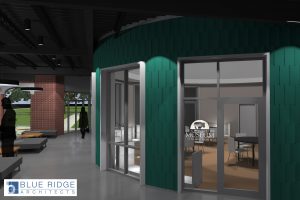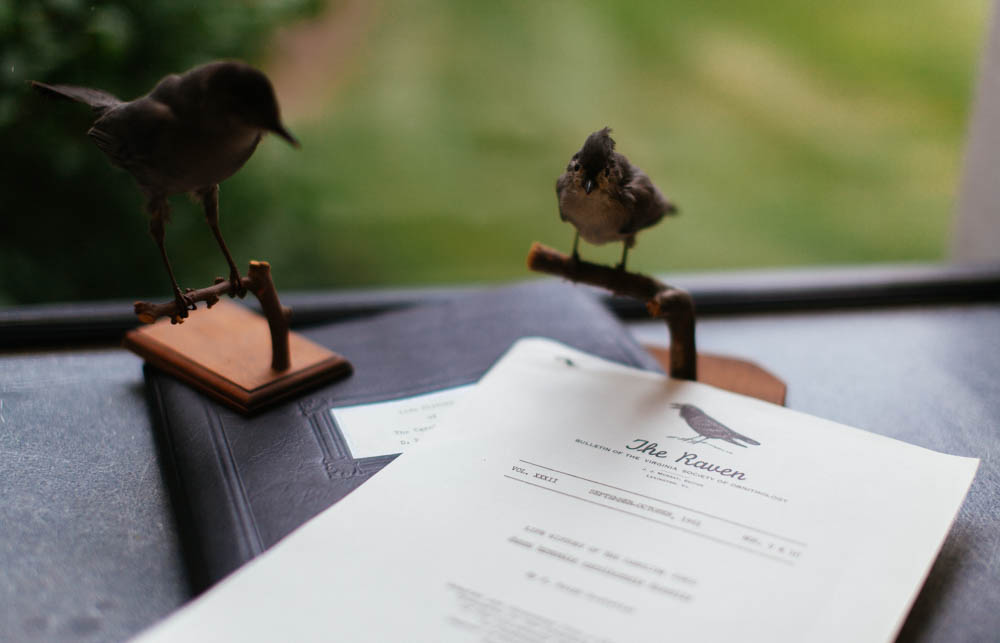While preparing exhibit items in the D. Ralph Hostetter Natural History Museum at Eastern Mennonite University for upcoming renovations, senior biochemistry major Eli Wenger found something that “made my hair stand on end.”
Wenger knew some names that live large in the university’s annals as movers and shapers of an academic legacy. Professor D. Ralph Hostetter, for example, taught biology, botany, ornithology and geology courses from 1924-66. He also served as the first director of Eastern Mennonite High School from 1938-57 while teaching at the college. Hostetter continued teaching part-time until 1974. He was both founder and curator of the museum that now honors his memory.
That’s why Wenger immediately recognized the report as an important piece of institutional history: the black-bound, frayed-at-the-edges folder displayed a simple silver-lined, white sticker with typewritten title: “Life History of The Carolina Junco/D. Ralph Hostetter.”
So too did Professor Jim Yoder, the museum’s current curator, who joined Wenger to appreciate the find.

“I often come across treasures like this that reflect the enduring love for science of professors who worked here before me,” said Yoder. “Whether it is discovering items like Hostetter’s dissertation or other unusual specimens in the museum collection that may not have been on display in years, I’m reminded of how important and meaningful such care for the natural world is for us today.”
Boyhood love of nature grows to professional devotion
Published in 1961, the report, an adaptation of Hostetter’s PhD dissertation, contains the masthead of “The Raven,” moniker of the bulletin of the Virginia Society of Ornithology. One can only guess how, 23 years after his study, Hostetter happened to return to his dissertation. However, the editor of “The Raven,” since its first edition in 1930 through 1969, was Professor J.J. Murray, who was Hostetter’s supervisor of field studies at UVa.
In the preface, we catch a glimpse of Hostetter’s love for nature. He writes, “Whose heart is not lightened by the first song of spring? Where is the country-bred and reared boy who does not find inspiration and charm in the color and song of birds? Is there anyone too busy with his work to pause for a moment before a nest of eggs or hungry nestlings, or to watch a distressed mother bird hurl epithets at a stray cat, or tenderly care for her brood?”
Hostetter came to EMS in 1924, accepting a $600 annual loss in salary – the equivalent of a $7,000 pay cut today – to shift from a Pennsylvania high school to Eastern Mennonite School. His master’s degree was in education from Harvard, which caused him to be viewed with suspicion by some board members.
In 1938, he earned his PhD in ornithology from the University of Virginia, one of the few professors on campus at the time to have earned a doctorate.

EMS grounds a reflection of ‘God through nature’
At EMS, Hostetter founded the Avian Society and also sponsored the high school Nature Society, “designed to bring students into closer contact with God through nature,” according to a 1953 yearbook entry Hostetter wrote. The club held monthly meetings and hosted field trips to local landmarks Tide Spring, Brock’s Gap, Rawley Springs, South River Falls and Mole Hill.
Hostetter’s interests were not limited to his students or academic pursuits. He lobbied for better care of the grounds. “In our Park,” he wrote, “…we find fish, eggshells, cans and rubbish dumped on the grounds, also pig pens built there. These things are very unsightly and obnoxious. We recommend that no more land be sold, but it be developed for the purposes stated above (a piece of ground…where students may get a touch of the wild; where they may study birds, flowers, trees, etc., as found in nature)… [T]ransplant and replant trees, plant wild flowers, preserve bird and wild life and keep grounds mowed in decent shape.”
Indeed, Hostetter’s urging is one reason why Park Woods are the pristine setting they still are today.
Museum curation in retirement
After retiring from teaching in 1966, Hostetter curated the natural history museum. Officially opened in 1968, it contains over 6,000 specimens, including many mammals and birds that the curator obtained and prepared for exhibition himself, and numerous rocks and minerals he acquired during extensive travels throughout the U. S., Mexico, Europe and Africa.

With hardly any acquisitions budget to speak of, he paid for most of the mounted heads that famously adorn the walls of Suter Science 106 out of his own pocket.
Yoder, the current curator, says he’s energized by the potential for updated space and a new generation of visitors to the museum. The new space will appropriately honor the life and legacy of one of EMU’s foremost promoters of the sciences, he adds.
“It has been an honor to care for the unique and quite remarkable collections Hostetter was able to establish over the course of his long career here,” Yoder said.
To learn more about the Suter West campaign, click here.

Dr. D. Ralph Hostetter was just one of the inspirational biologists I encountered during my years at EMC. A true gentleman scholar, he once offered me a position as his museum assistant… if I would first shave my mustache (what he referred to as that little problem under my nose). Wonderful memories! Hostetter, Homer Mumaw, J. Mark Brubaker, and especially A. Clair Mellinger were profound influences as well, and I’ll always be in their debt. C.K. McMullen, Professor, JMU
Dr. Hostetter retired from part-time teaching the year before I came to EMC so I didn’t have the pleasure of having him as a professor, although like Conley, I do recognize the important influences that Homer Mumaw and Clair Mellinger had on my career. I’ve just retired as a research ornithologist with U.S. Geological Survey and find it wonderful to hear of this ornithological discovery of Dr. Hostetter’s contribution. Here’s hoping that it might be available in electronic form at some point. J.M. Ruth, Ph.D., USGS retired
Thanks for your interest. The Raven can be found online at http://www.virginiabirds.org/publications/the-raven/